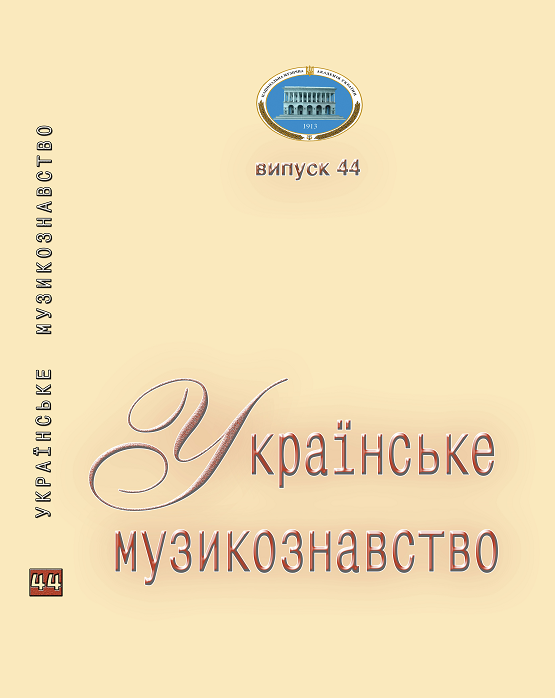Ornaments in the baroque keyboard music: the questions of notation
DOI:
https://doi.org/10.31318/0130-5298.2018.44.0.152524Keywords:
ornaments, embellishment, music score, music communicationAbstract
The article is devoted to the questions of ornamentation in the baroque keyboard music, which is viewed here as a peculiar code of the communication between composer and performer. Relevance of the study lies in the solving of the problem – the fact that the codes in the musical text are not self-explanatory and requires from the performer a knowledge the symbols themselves and historical context. That is why further explanations or tables were apprended to the musical scores of many baroque composers. In Ukrainian musicology this area is still not enough investigated. Thus, the main objective of the study is in filling the blanks in the topic, involving to the domain of research the foreign scholar sources and the experience of the authoritative foreign colleagues. During the research both theoretical and empirical methods were applied: analysis of pieces of music, comparison of various samples of the ornamentation in the various context and analyzing ornamentation in different national schools.
The Results of research were received during the study of theoretical literature, analysis and processing of the information and during teaching harpsichord at Glier Kiev Music Institute. The study was done following the experience received by empirical way: the masterclasses with the European experts and my own work on this repertoire, I have accumulated significant experience in the field of Baroque ornamentation for passing it to the next generation of performers. One of the results of this process is the acceptance of the one ofmy graduates, D. Kokoshinsky at Schola Cantorum Basiliensis.
Сonclusions. The Ukrainian school of HIP should be seen as a phenomenon of a great artistic potential that is developing rapidly, and that is still in need of expansion of its informationaltheoretical base. Its significance for art and education lies in the possibility to integrate Ukraine into European context and to raise the level of the cultural life in the country.
References
Gerasymova-Persyds’ka, N. (1979), “Dialog with the past”, Muzyka [Music],№ 6, p. 8 [in Ukrainian].
Kandaurova, L. (2018), “Alexei Lyubimov: «I do not grieve about the exhaustion of the classical spirit»”, available at: http://www.colta.ru/articles/music_modern/18107 (accessed 19 Aug. 2018) [in Russian].
Couperin, F. (1973), The art of playing the harpsichord, Muzyka, Moscow, 152 p. [in Russian].
Nayduyk, О. (2018), “Baroque masterclass by Olha Pasichnyk”, available at: http://kyivdaily.com.ua/2018/10/15/barokoviy-mayster-klas-vid-olgi-pasi/ (accessed 29 Sep. 2018) [in Ukrainian].
Sikorska, N. (2016), Baroque Keyboard Music in the Second half ХІХ century's editions: Establishment of the Historically Informed Performance, PhD diss. (art crit.), National Music Academy of Ukraine, 287 p. [in Ukrainian].
Harnoncourt, N. (2002), Music as the language of sounds. The way to the new understanding of the music, Sobor, Sumi, 184 p. [in Ukrainian].
Shabaltina, S. (2013), Harpsichord through the ages. Notes of an artist, Ukrainskyy priorytet, Kiev, 160 p. [in Ukrainian].
Shadrina-Lychak, O. (2016), “Non-mesured prelude as a phenomenon of the performing arts of the baroque era”, Kyivs'ke muzykoznavstvo [Kyiv musicology], issue 54, pp. 236–245 [in Russian].
Booth, C. (2010), “Did Bach Really Mean That?: Deceptive Notation in Baroque Keyboard Music”, Soundboard, Wells, 349 p.[in English].
Dolmetsch, A. (2005), The interpretation of the Music of the 17th and 18th Centuries. Dover publications, INC., Mineola – NY, 518 р. [in English].
Frescobaldi, G. (1616), Al lettore / G. Frescobaldi // Il secondo libro di toccate, canzone, versi d’hinni, magni cat, gagliarde, correnti et alter partite d’intavolatura di cimbalo et organo di Girolamo Frescobaldi, organist in S. Pietro di Roma. Niccolo Borbone, Rome, Р. 5 [in Italian].
Schulenberg, D. (2012), «Ornaments, Fingerings, and Authorship: Persistent Questions About English Keyboard Music circa 1600», available at: http://faculty.wagner.edu/davidschulenberg/files/2012/12/Ornaments_fingerings_authorship_101112.pdf (accessed 15.10.2018) [in English].


